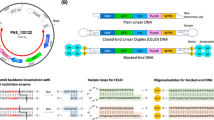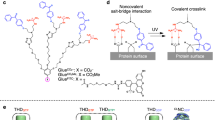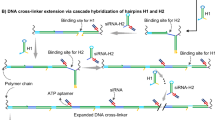Abstract
In nonviral gene therapy approaches, the linkage of signal molecules to plasmid DNA (pDNA) is of interest for guiding its delivery to the nucleus. Here, we report its linkage to a peptide (P79–98) mediating migration on microtubules by using a triplex-forming oligonucleotide (TFO). pDNA of 5 kbp and 21 kbp containing 6 and 36 oligopurine • oligopyrimidine sites (TH), respectively, inserted outside the luciferase gene sequence were used. TFO with a dibenzocyclooctyl (DBCO) group in 3’ end comprising some Bridged Nucleic Acid bases was conjugated by click chemistry with the peptide carrying an azide function in the C-terminal end. We found the formation of 6 and 18 triplex with pDNA of 5 kbp and 21 kbp, respectively. A twofold increase of the transfection efficiency was observed in the hind-limbs upon Hydrodynamic Limb Vein (HLV) injection in mice of naked P79–98 –pDNA of 21 kbp. This work paves the way for the selective equipping of pDNA with intracellular targeting molecules while preserving the full expression of the encoded gene.
This is a preview of subscription content, access via your institution
Access options
Subscribe to this journal
Receive 12 print issues and online access
$259.00 per year
only $21.58 per issue
Buy this article
- Purchase on Springer Link
- Instant access to full article PDF
Prices may be subject to local taxes which are calculated during checkout





Similar content being viewed by others
References
Delalande A, Bastie C, Pigeon L, Manta S, Lebertre M, Mignet N, et al. Cationic gas-filled microbubbles for ultrasound-based nucleic acids delivery. Biosci Rep. 2017;37:1–18.
Delalande A, Postema M, Mignet N, Midoux P, Pichon C. Ultrasound and microbubble-assisted gene delivery: recent advances and ongoing challenges. Ther Deliv. 2012;3:1199–215.
Gibot L, Rols MP. Gene transfer by pulsed electric field is highly promising in cutaneous wound healing. Expert Opin Biol Ther. 2016;16:67–77.
Kolosnjaj-Tabi J, Gibot L, Fourquaux I, Golzio M, Rols MP. Electric field-responsive nanoparticles and electric fields: physical, chemical, biological mechanisms and therapeutic prospects. Adv Drug Deliv Rev. 2019;138:56–67.
Pasquet L, Bellard E, Chabot S, Markelc B, Rols MP, Teissie J, et al. Pre-clinical investigation of the synergy effect of interleukin-12 gene-electro-transfer during partially irreversible electropermeabilization against melanoma. J Immunother Cancer. 2019;7:161.
Rochard A, Scherman D, Bigey P. Genetic immunization with plasmid DNA mediated by electrotransfer. Hum Gene Ther. 2011;22:789–98.
Sharma D, Arora S, Singh J, Layek B. A review of the tortuous path of nonviral gene delivery and recent progress. Int J Biol Macromol. 2021;183:2055–73.
Trollet C, Bloquel C, Scherman D, Bigey P. Electrotransfer into skeletal muscle for protein expression. Curr Gene Ther. 2006;6:561–78.
Zhang G, Budker V, Wolff JA. High levels of foreign gene expression in hepatocytes after tail vein injections of naked plasmid DNA. Hum Gene Ther. 1999;10:1735–7.
Jafari M, Soltani M, Naahidi S, Karunaratne DN, Chen P. Nonviral approach for targeted nucleic acid delivery. Curr Med Chem. 2012;19:197–208.
Junquera E, Aicart E. Recent progress in gene therapy to deliver nucleic acids with multivalent cationic vectors. Adv Colloid Interface Sci. 2016;233:161–75.
Mintzer MA, Simanek EE. Nonviral vectors for gene delivery. Chem Rev. 2009;109:259–302.
Ogris M, Wagner E. To be targeted: is the magic bullet concept a viable option for synthetic nucleic acid therapeutics? Hum Gene Ther. 2011;22:799–807.
Rezaee M, Oskuee RK, Nassirli H, Malaekeh-Nikouei B. Progress in the development of lipopolyplexes as efficient nonviral gene delivery systems. J Control Release. 2016;236:1–14.
Thorne B, Takeya R, Vitelli F, Swanson X. Gene therapy. Adv Biochem Eng Biotechnol. 2017;165:1–49.
Tros de Ilarduya C, Sun Y, Duzgunes N. Gene delivery by lipoplexes and polyplexes. Eur J Pharm Sci. 2010;40:159–70.
Lechardeur D, Sohn KJ, Haardt M, Joshi PB, Monck M, Graham RW, et al. Metabolic instability of plasmid DNA in the cytosol: a potential barrier to gene transfer. Gene Ther. 1999;6:482–97.
Bureau MF, Naimi S, Torero Ibad R, Seguin J, Georger C, Arnould E, et al. Intramuscular plasmid DNA electrotransfer: biodistribution and degradation. Biochim Biophys Acta. 2004;1676:138–48.
Lukacs GL, Haggie P, Seksek O, Lechardeur D, Freedman N, Verkman AS. Size-dependent DNA mobility in cytoplasm and nucleus. J Biol Chem. 2000;275:1625–9.
Bai H, Lester GMS, Petishnok LC, Dean DA. Cytoplasmic transport and nuclear import of plasmid DNA. Biosci Rep. 2017;37:1–17.
Merino-Gracia J, Garcia-Mayoral MF, Rodriguez-Crespo I. The association of viral proteins with host cell dynein components during virus infection. FEBS J. 2011;278:2997–3011.
Engelke MF, Burckhardt CJ, Morf MK, Greber UF. The dynactin complex enhances the speed of microtubule-dependent motions of adenovirus both towards and away from the nucleus. Viruses. 2011;3:233–53.
Suikkanen S, Aaltonen T, Nevalainen M, Valilehto O, Lindholm L, Vuento M, et al. Exploitation of microtubule cytoskeleton and dynein during parvoviral traffic toward the nucleus. J Virol. 2003;77:10270–9.
Midoux P, Pigeon L, Goncalves C, Pichon C. Peptides mediating DNA transport on microtubules and their impact on non-viral gene transfer efficiency. Biosci Rep. 2017;37:1–16.
Pigeon L, Goncalves C, Gosset D, Pichon C, Midoux P. An E3-14.7K peptide that promotes microtubules-mediated transport of plasmid DNA increases polyplexes transfection efficiency. Small. 2013;9:3845–51.
Horwitz MS. Function of adenovirus E3 proteins and their interactions with immunoregulatory cell proteins. J Gene Med. 2004;6:S172–83.
Slattum PS, Loomis AG, Machnik KJ, Watt MA, Duzeski JL, Budker VG, et al. Efficient in vitro and in vivo expression of covalently modified plasmid DNA. Mol Ther. 2003;8:255–63.
Neves C, Byk G, Scherman D, Wils P. Coupling of a targeting peptide to plasmid DNA by covalent triple helix formation. FEBS Lett. 1999;453:41–5.
Branden LJ, Mohamed AJ, Smith CI. A peptide nucleic acid-nuclear localization signal fusion that mediates nuclear transport of DNA. Nat Biotechnol. 1999;17:784–7.
Roulon T, Coulaud D, Delain E, Le Cam E, Helene C, Escude C. Padlock oligonucleotides as a tool for labeling superhelical DNA. Nucleic Acids Res. 2002;30:E12.
Roulon T, Helene C, Escude C. Coupling of a targeting peptide to plasmid DNA using a new type of padlock oligonucleotide. Bioconjug Chem. 2002;13:1134–9.
Cozens AL, Yezzi MJ, Kunzelmann K, Ohrui T, Chin L, Eng K, et al. CFTR expression and chloride secretion in polarized immortal human bronchial epithelial cells. Am J Respir Cell Mol Biol. 1994;10:38–47.
Bertrand E, Goncalves C, Billiet L, Gomez JP, Pichon C, Cheradame H, et al. Histidinylated linear PEI: a new efficient non-toxic polymer for gene transfer. Chem Commun. 2011;47:12547–9.
Goncalves C, Gross F, Guegan P, Cheradame H, Midou P. A robust transfection reagent for the transfection of CHO and HEK293 cells and production of recombinant proteins and lentiviral particles - PTG1. Biotechnol J. 2014;9:1380–8.
Gomez JP, Tresset G, Pichon C, Midoux P. Improved histidinylated lPEI polyplexes for skeletal muscle cells transfection. Int J Pharm. 2019;559:58–67.
Kilkenny C, Browne WJ, Cuthill IC, Emerson M, Altman DG. Improving bioscience research reporting: the ARRIVE guidelines for reporting animal research. PLoS Biol. 2010;8:e1000412.
Zhang G, Wooddell CI, Hegge JO, Griffin JB, Huss T, Braun S, et al. Functional efficacy of dystrophin expression from plasmids delivered to mdx mice by hydrodynamic limb vein injection. Hum Gene Ther. 2010;21:221–37.
Le Guen YT, Le Gall T, Midoux P, Guegan P, Braun S, Montier T. Gene transfer to skeletal muscle using hydrodynamic limb vein injection: current applications, hurdles and possible optimizations. J Gene Med. 2020;22:e3150.
Zelphati O, Liang X, Hobart P, Felgner PL. Gene chemistry: functionally and conformationally intact fluorescent plasmid DNA. Hum Gene Ther. 1999;10:15–24.
Miyashita K, Rahman SM, Seki S, Obika S, Imanishi T. N-Methyl substituted 2’,4’- BNANC: a highly nuclease-resistant nucleic acid analogue with high-affinity RNA selective hybridization. Chem Commun. 2007;36:3765–7.
Rahman SM, Seki S, Obika S, Haitani S, Miyashita K, Imanishi T. Highly stable pyrimidine-motif triplex formation at physiological pH values by a bridged nucleic acid analogue. Angew Chem Int Ed Engl. 2007;46:4306–9.
Rahman SM, Seki S, Utsuki K, Obika S, Miyashita K, Imanishi T. Synthesis and properties of 2’,4’-BNA(NC), a second generation BNA. Nucleic Acids Symp Ser. 2005;49:5–6.
Hertoghs KM, Ellis JH, Catchpole IR. Use of locked nucleic acid oligonucleotides to add functionality to plasmid DNA. Nucleic Acids Res. 2003;31:5817–30.
Fan Z, Kocis K, Valley R, Howard JF, Chopra M, An H, et al. Safety and feasibility of high-pressure transvenous limb perfusion with 0.9% saline in human muscular dystrophy. Mol Ther. 2012;20:456–61.
Fan Z, Kocis K, Valley R, Howard JF Jr, Chopra M, Chen Y, et al. High-pressure transvenous perfusion of the upper extremity in human muscular dystrophy: a safety study with 0.9% saline. Hum Gene Ther. 2015;26:614–21.
Hagstrom JE, Hegge J, Zhang G, Noble M, Budker V, Lewis DL, et al. A facile nonviral method for delivering genes and siRNAs to skeletal muscle of mammalian limbs. Mol Ther. 2004;10:386–98.
Hegge JO, Wooddell CI, Zhang G, Hagstrom JE, Braun S, Huss T, et al. Evaluation of hydrodynamic limb vein injections in nonhuman primates. Hum Gene Ther. 2010;21:829–42.
Le Guen YT, Pichon C, Guegan P, Pluchon K, Haute T, Quemener S, et al. DNA nuclear targeting sequences for enhanced non-viral gene transfer: an in vitro and in vivo study. Mol Ther Nucleic Acids. 2021;24:477–86.
Acknowledgements
We warmly thank “Association Française contre les Myopathies” (AFM, Evry, France), ‘Vaincre la mucoviscidose’ (VLM, France) and “Association Gaetan Saleun” (Brest, France).
Funding
This study was co-funded by “Association Française contre les Myopathies” (Strategic project ##20609) (AFM, Evry, France) and ‘Vaincre la mucoviscidose’ (project RF2016050182) (VLM, France). DM was co-founded by AFM and VLM. CG received a PhD fellowship from University of Orléans and Région Centre Val de Loire.
Author information
Authors and Affiliations
Contributions
CG, DM, and CG conducted the in vitro experiments and acquired data. YTG and KP conducted the in vivo experiments and acquired data. PM and TM analyzed data and wrote the manuscript. TM and PM obtained funding acquisition. All authors critically reviewed and approved the final manuscript.
Corresponding authors
Ethics declarations
Competing interests
The authors declare no competing interests.
Additional information
Publisher’s note Springer Nature remains neutral with regard to jurisdictional claims in published maps and institutional affiliations.
Rights and permissions
About this article
Cite this article
Girardin, C., Maze, D., Gonçalves, C. et al. Selective attachment of a microtubule interacting peptide to plasmid DNA via a triplex forming oligonucleotide for transfection improvement. Gene Ther 30, 271–277 (2023). https://doi.org/10.1038/s41434-022-00354-1
Received:
Revised:
Accepted:
Published:
Issue Date:
DOI: https://doi.org/10.1038/s41434-022-00354-1



